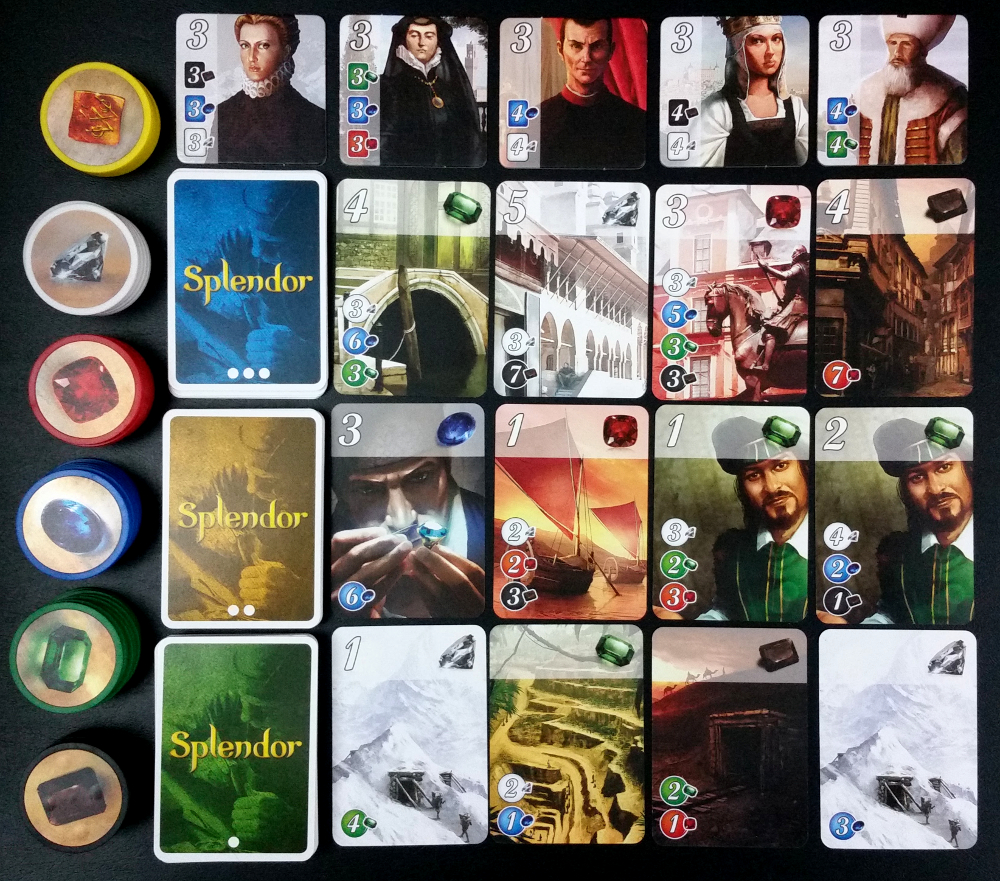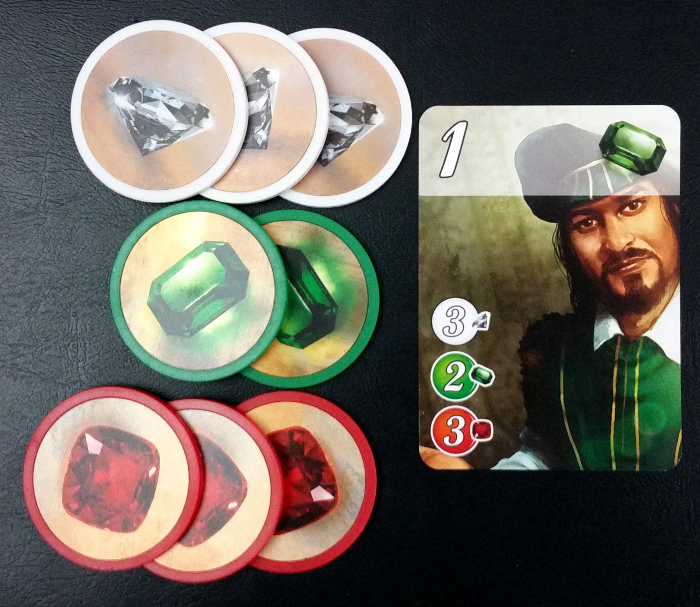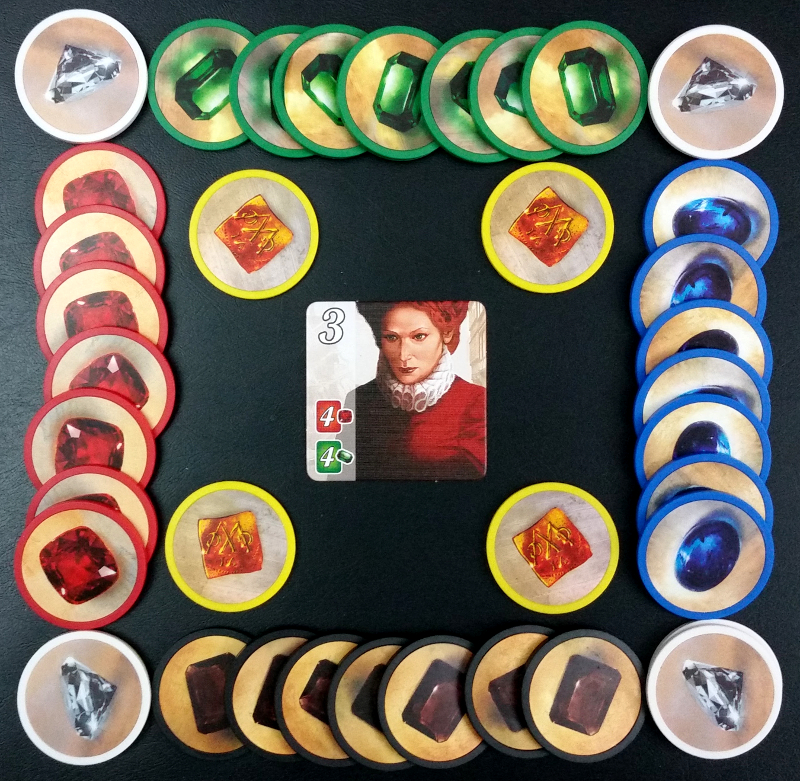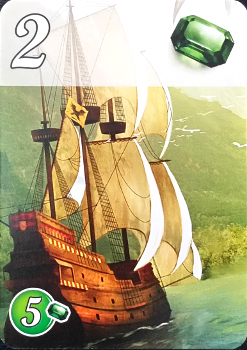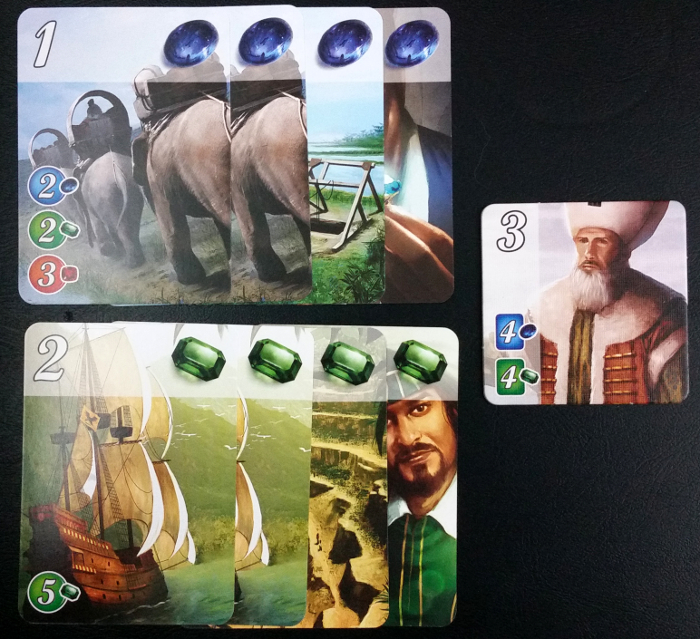The market is dusty and your eyes are dry, itchy from the sand that just seems to get everywhere. You need to find something to eat and get back home before mother starts wondering where you are, but you can’t seem to tear yourself away from the long line of impressive stalls. Luxurious fabrics, delicate jewelry – all of it splayed out for your admiring gaze. Your favorites are the gemsellers, though. The four most prominent of them sit in adjacent stalls, each with a table full of rubies and sapphires and stones you don’t even know the name of. You know better than to get too close, but you watch from afar and wonder if one day you could be one of them.
The Premise
Splendor is a game about buying and selling gems. As respected gem merchants, players take turns collecting raw gem chips and using them to buy increasingly-valuable cards from the central market in the hopes of assembling the most luxurious gem collection around and catching the attention of the local nobility.
The Rules
Splendor is a concise game of simple set collection and basic Resource Management that’s neither complicated to play nor to set up. Splendor exists entirely of six token stacks (five gem colors plus gold tokens), three Development decks, and a handful of noble tiles.
To begin, each Development deck is shuffled and placed in a column on the table in descending order. Then, the top four cards of each deck are revealed in that row, creating a 4×3 grid. Finally, a number of noble tiles are randomly chosen and placed above the grid. The youngest player begins the game.
Splendor takes place over an undetermined number of rounds, broken into turns. Each turn, a player may perform one of three actions: Take gem tokens, Reserve a card, or Purchase a card. If the player chooses to Take gems, they may either choose three gem tokens of different colors or two tokens of the same color. However, taking two tokens of the same color is only allowed if there are at least four tokens of that color available – a player can’t take the final two rubies, for example. Players are limited to ten tokens at the end of their turn.
Players may instead Reserve a Development card by choosing one from the grid or – sight unseen – from the top of one of the Development decks. Every Development card corresponds to one of Splendor’s five gem types. Up to three of these cards may be kept in hand at any given time. Whenever a player Reserves a card this way, they also collect a gold token if available.
The third action, and the one players need to complete to score points, is to Purchase a Development card. Cards can be purchased either from the player’s hand or directly from the card grid, which is then replenished. To Purchase a card, a player must pay the associated cost in gems, with gold acting as any gem type.
Once purchased, Development cards remain in that player’s tableau for the entirely of the game. These cards act as permanent bonus gems that reduce the cost of future Development cards by one each of their type. Most cards also grant VP when attained, which is equally as valuable.
Moreover, certain combinations of Development cards can also earn a player the attention of the nobles. At the end of their turn, if a player has enough cards to match those listed on one noble’s tile, they claim that noble. Each noble is worth 3 VP.
The first player to reach 15 VP triggers the end of the game. At that point, the current round is finished and whoever has the most VP is the winner, having demonstrated that they are the true gem master and jewelry maker in the marketplace.
Sourcing Quality Goods
Considering that Splendor is literally about collecting and refining precious materials, it’s fitting that the game invests so much in the quality of its components. The nobles are printed on thick cardboard squares and the cards themselves are durable enough to a fair amount of wear. Yet the highlight to Splendor’s physical attributes resides with the gems themselves. Each gem in the game is represented by a hefty poker chip, and collecting them continuously gives you a visceral sense of satisfaction. The weight of these chips helps players to feel immersed in the game, like they have something tangible and valuable at their disposal.
These gems do have one mild imperfection, however, in the form of their icon stickers. Although color-coded, each Splendor chip also has a sticker on them depicting their respective gem, and over time these stickers have a tendency to curl or detach. While this issue is minor and easily rectified, it’s unfortunate that this can start to happen in just a few playthroughs.
That said, working with the gem chips are an enjoyable and satisfying part of the game’s experience. Indeed, thanks to their presence, Splendor’s poker chips elevate the gameplay from ordinary to…well, splendid.
Genuine Cubic Zirconia
As much as the game’s gem tokens elicit positive sentiment due to their sturdiness and oddly-pleasing trademark clinking sounds, though, their purpose in the game is more practical than thematic. Rather than potentially using gem shapes or similarly flavorful resource representation, the game opts for a more functional approach. While their weight works on an almost subconscious level to reinforce the notion that you’re working with precious stones, their visual presence also underscores that the gem-selling theme of Splendor is pretty lightly applied.
Ultimately, the game’s gem-selling theme is going to be far too light to keep an Immersionist interested. The entire concept of Splendor is subtle enough to border on the abstract. For instance, the artwork of each Development deck is supposed to represent the path of your rise to artisanal prowess, from mining raw materials, to transporting them to market, to refining them into valuable jewelry. Yet this is never explicitly mentioned outside of the rulebook and can be easily missed.
Indeed, although a gem-centric flavor can be found throughout the game, the only place where the theme itself is invoked is by way of the card images. The artwork to the cards in Splendor are well crafted in their own right, but they (perhaps intentionally) don’t generally pull your attention from the card’s more utilitarian purposes. As a result, Splendor’s theme is barely felt aside from the rare noble’s visit, coming off as largely superficial.
Still, while the look of Splendor isn’t necessarily enough to hold an Immersionist’s attention, it is enough to catch the eye of passing Socializers. Its simple layout, combined with very light rules and short play time, creates an ideal casual setting. Splendor caters to a crowd that prefers a less-is-more style of gaming, making it great for new gamers or those seeking a brief game that provides purpose and a slight challenge but isn’t mentally taxing.
From Pauper To Prince
The downside to all this collecting and building is that Splendor can feel a bit like a solitaire game. Because the game rewards players for focusing intently on their own strategies, it’s easy to get so invested in one’s tableau, or the cards and materials that you’ve laid out before them, that you can simply forget about what everyone else is doing.
Even though Splendor provides a casual atmosphere that’s accessible to an incredibly wide spectrum of gamers, it isn’t terribly interactive. There is no direct way to aggressively affect another player or interfere with their gem supplies, much to the chagrin of Strikers everywhere. The closest you can get to out-and-out warfare here is by swiping a card from the grid you think they are after before they can fulfill it. Not only are such moves uncommon, however, but they often also aren’t as advantageous as it seems since spending precious time and resources to stop a single opponent could hinder your own chances of winning. Splendor’s style is more gentleman’s race than bazaar brawl.
On the other hand, this is precisely the kind of game for those who like to develop long-term strategies and / or amass their wealth – namely Architects and Tacticians. Splendor has two dominant strategies, or paths to victory that are most likely to succeed, and the game is more about who can most efficiently pursue those strategies rather than who can develop an entirely new plan of attack. Some players choose to go for diversity, collecting anything and everything that they can in the hopes that they’ll amass enough cumulative wealth to be competitive. For Architects, this is all they could possibly want from a half hour game.
Other players (such as Tacticians) are more focused, choosing one or two Nobles or high-level cards and concentrating on acquiring those to the exclusion of any cards that don’t fit their master plan. In a way, this makes Splendor play a little like a tech tree. This latter style has you appreciate that even for a quick game with limited options and equally limited variation from one session to the next, Splendor impressively still leaves plenty of room for planning ahead.
The caveat to these linear approaches is that turns can sometimes feel wasted because no good opportunities are available based on your strategy. While there’s always something you can do, it might not be exactly what you want to do every single time. As such, a little flexibility is to be expected. In the end, though, neither approach is better or worse; both can win depending on luck and the skill of the players involved.
This also means that while there is that element of luck to Splendor in terms of which cards are revealed from the deck, it relies more on making solid choices than it does on tactical experimentation. This is likely to turn off Daredevils, who enjoy being given room to make offbeat decisions and pursue untested strategies.
The Takeaway
At its jewel-loving core, Splendor is a collector’s game. From building up chip stacks to amassing a lustrous array of gem cards, Splendor both embodies and rewards the simple act of stockpiling your way to victory. While playthroughs often feel similar to one another, its natural pacing never shifts focus away from the basic yet entertaining act of collecting items that it encapsulates so well – which is why Splendor remains incredibly replayable.
It also doesn’t hurt that the production value is so high.
With quality components, simple rules, and highly intuitive gameplay, Splendor is the sort of lightweight Gateway Game that appeals to casual participants and calculating thinkers alike. It’s compelling, short, and allows you to test your lapidary skills against your competitors free from direct player conflict. Truly, Splendor is a gem to behold.
Splendor is a product of Asmodee Editions.
Cardboard Republic Snapshot Scoring (Based on scale of 5):
Artwork: 3.5
Rules Clarity: 5
Replay Value: 5
Physical Quality: 4
Overall Score: 4.5

